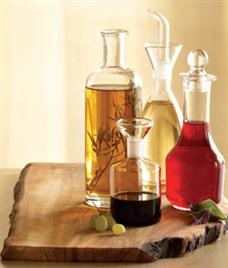Literally meaning ‘sour wine’ in French, vinegar has evolved from humble beginnings to become a stock standard in the kitchen.
By Dominique Brown
This tart, sweet and useful ingredient came about over 10 000 years ago, probably through a simple error. When wine was found to be undrinkable after it had oxidised, it was simply put to other uses. In 5000 BC it was used as a preservative by the Babylonians; it was thought to prevent the spread of germs during the bubonic plague, and in World War I soldiers used it to treat wounds. Nowadays we use it in all its forms to flavour food, as a preservative, often for its cleaning abilities and for health purposes – it has excellent antibacterial properties.
Vinegar can essentially be made from any food that contains sugar. Naturally occurring yeasts turn the sugar into alcohol and then bacteria changes the alcohol into vinegar. The food used to create the base of the vinegar as well as the ageing process dictate the ultimate taste.
We asked three chefs about the vinegars they keep in their storecupboards:
ANDREW GREEN OF CLICO BOUTIQUE HOTEL, JOBURG

Which vinegars should be standard in any kitchen cupboard? White and red wine and herb-infused vinegars, cider vinegar and white balsamic, as well as aged balsamic.
What are your best tips for vinegar? Aged balsamic is best left alone so that you can appreciate the real taste – just drizzle it over vine tomatoes with extra virgin olive oil, buffalo mozzarella and sourdough; pure heaven! And your flavoured vinegars are great for making Béarnaise or other egg-based sauces with a twist, or for simple salad dressings.
Granny Smith apple and tarragon dressing
Ingredients:
5ml (1 tsp) mustard
5ml (1 tsp) fresh tarragon
125ml (½ cup) vegetable oil
125ml (½ cup) cider vinegar
175ml pressed Granny Smith
apple juice
salt and freshly ground black pepper, to taste
Method:
Mix the mustard together with the fresh tarragon and whisk in the oil, vinegar and apple juice. Season, then drizzle over a roasted beetroot and goat’s cheese salad with toasted walnuts and freshly picked rocket.
JACQUE SWART OF CALICO & CREAM CATERERS, JOBURG

Do you have a favourite type of vinegar? I prefer balsamic for its deep, sweet, strong and versatile flavour.
Which vinegars should be stock standard in any kitchen? Balsamic, white wine and red wine vinegar.
What are your favourite uses for vinegar? Most commonly in a vinaigrette or salad dressings, but also reductions, sauces like hollandaise or Béarnaise, flavoured vinegars, chutneys and jams.
Gooseberry and cinnamon flavoured vinegar
Ingredients:
500ml (2 cups) balsamic vinegar
500ml (2 cups) white wine vinegar
1½ cups gooseberries (fresh or frozen)
1 cinnamon stick
Method:
- Bring the vinegars to a boil in a medium pot.
- Place the gooseberries and cinnamon inside a sterilised, heat-proof glass jar.
- Pour the hot vinegar through a funnel, over the fruit. Cover and place in a cool dark area.
- Allow the vinegar to stand for at least 12 days before using.
DESMOND MORGAN, EXECUTIVE CHEF, SHERATON PRETORIA HOTEL
.jpg)
What do you regard as the most versatile vinegar? White spirit vinegar.
What dimension does vinegar add to a dish? It lifts flavours instantly, balances sweet and sour, extends shelf life and makes batter crispy when fried.
Granadilla and raspberry vinaigrette
Ingredients:
2 jumbo free-range egg yolks
5ml (1 tsp) smooth French
Dijon mustard
15ml (1 tbsp) crushed raspberries (about 3)
1 sprig of fresh thyme
15ml (1 tbsp) raspberry vinegar
100ml vegetable oil (olive oil is too strong)
5ml (1 tsp) lemon juice
15ml (1 tbsp) mixed bell peppers, finely diced (brunoise cut)
15ml (1 tbsp) spring onion, finely diced (include some of the green leaf)
5ml (1 tsp) fresh dill, chopped
pulp of 1 granadilla
salt and white pepper, to taste
Method:
- Whisk the egg yolks in a roundbottomed mixing bowl. Add mustard, crushed raspberries, fresh thyme off the sprig and half of the vinegar.
- Keep whisking until pale in colour and slightly thickened. Drip the oil in slowly while whisking continuously until all the oil has been incorporated.
- Add the rest of the vinegar, lemon juice, peppers, spring onion, fresh dill and granadilla pulp (including pips).
- Thin the dressing down with a few drops of ice-cold water, if necessary. Season.
- Use the dressing for seafood salad, linefish with salad, prawn dip, butterfish or any tropical or smoked fish.

